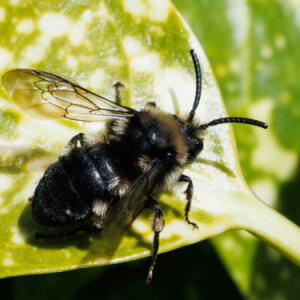Glittery
I spent quite a lot of today working in the wild garden (eeeurgh), finishing the pruning of the dogwood, and improving the scrub clearance underneath our huge red chestnut tree. I also cut down several stray elder saplings, which I wouldn't even have thought of tackling before buying the power secateurs. The problem with elder is that it happily regenerates from cut stumps, but if you're prepared to keep cutting it back, it does eventually tend to get discouraged.
My reward for all this horticultural effort was finding two season's firsts as I trudged back and forth through the top garden: this fabulously glittery Honeysuckle Sawfly (Abia lonicerae), and two Common Mourning Bees (Melecta albifrons), one of which I've added as tonight's extra.
Abia lonicerae is my very favourite sawfly, but it's skittish and shy, especially when fresh, and I'm always delighted when I spot one. I've always believed that it was virtually impossible to sex this species unless you see a female actually laying eggs, but according to Steven Falk the males have a rather strange dull patch on T4-T6 of the abdomen, while females are not only chunkier in the body, but have thicker 3rd and 4th antennal segments as well. Chunkiness is hard to assess in isolation, of course, but the patchy abdomen seems like an obvious identification feature - though I have to say that I haven't actually seen it described by anyone else. However, if it's true, my specimen here is a female, because an earlier image in my sequence caught her with her wings outspread, and there was no dull patch on her abdomen.
Common Mourning Bees are kleptoparasites of Hairy-footed Flower Bees, and their emergence always seems to coincide very neatly with the arrival of the female Plumpies. That said, both today's specimens were males, so they won't actually be doing any nest invasion themselves. Melecta albifrons are about 13mm long - the females a little larger, and the males slightly smaller - and the general impression they give in flight is of being either grey and black, or sometimes entirely black, so they can be mistaken for either female Hairy-footed Flower Bees or Ashy Mining Bees. Luckily female Plumpies are faster and more purposeful, and as soon as they land you can see their bright ginger pollen brushes, so they can be quite easily discounted. Male Ashy Miners are smaller and slimmer than this, and much more skittish, and though female Ashy Miners are about the same size as a Common Mourning Bee, they're much neater, with two tidy grey bands at the top and bottom of the thorax and a glossy black abdomen.
Where they're present (which is usual, but not invariable), the clinching identifiers of a Common Mourning Bee are the tufts of white hair along the edges of its abdomen and on its legs. But even where these tufts aren't present, Melecta albifrons always looks untidy and rather hunched - especially female specimens, which are bigger than the males and appear especially bulky around the thorax. In fact, though it's a word I hesitate to use about an insect, female Common Mourning Bees are really rather ugly.


Comments
Sign in or get an account to comment.


